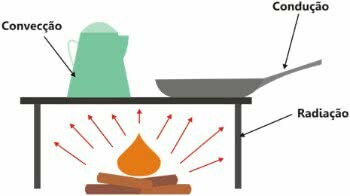Energy in physics is an extremely important concept and represents the ability to produce work.
It is also used in other scientific fields such as biology and chemistry.
Living beings depend on energy to survive and obtain it through food (chemical energy). In addition, organisms also receive energy (light and heat) from the Sun.
energy source
Follow the source of energy in the infographic below.

Infographic - Origin of the energy we use on Earth
General Principle of Energy Conservation
The law of energy conservation is fundamental. She says that energy is not lost, nor can it be destroyed, it transforms. Thus, in an isolated system the amount of energy remains constant.
Example
The energy that comes from the sun heats the water (sensible heat). This heating causes the transport of steam to the atmosphere, forming clouds (latent heat and gravitational potential energy).
When the water returns to the surface (kinetic energy), it forms lakes and rivers that will later be dammed (gravitational potential energy).
The water falling through the spillway (kinetic energy) moves the turbine blades that transform it into the generator into electrical energy.
Types of Energy
Energy comes in many forms. the main types of energy studied in Physics are:
Mechanical Energy
Mechanical Energy it is understood as the capacity of a body to do work. Basically, mechanical energy is related to two different ways:
THE Kinetic energy, which is the energy of moving bodies.
THE Potential energy, which is the energy stored in bodies with the ability to transform into movement.
Thermal energy
It is the energy related to the degree of movement of subatomic particles. The higher the temperature of a body, the greater its internal energy.
When a higher temperature body comes in contact with or a lower temperature body, heat transfer will occur.
Learn more aboutThermal energy.
Electricity
It is the energy produced from the electrical charges of subatomic particles. As charges move, they generate electrical current, creating what we call electricity.
Read more aboutElectricity.
light energy
Light is radiant energy that manifests through visible light, that is, the light that we can perceive with the sense of sight.
Read more about Light.
Sound Energy
It is the type of energy that can be perceived by the sense of hearing. Sound, like light, is a wave.
Read more about thewaves.
Nuclear energy
THE Nuclear energy it is the energy contained in the nucleus of atoms and emitted in the form of radiation or particles. Radiation is widely used in medicine, X-rays, radiotherapy, but it is also associated with negative effects such as atomic bombs and nuclear waste.
You may also be interested in:
- Physics Formulas
- Strength
- Calorimetry

